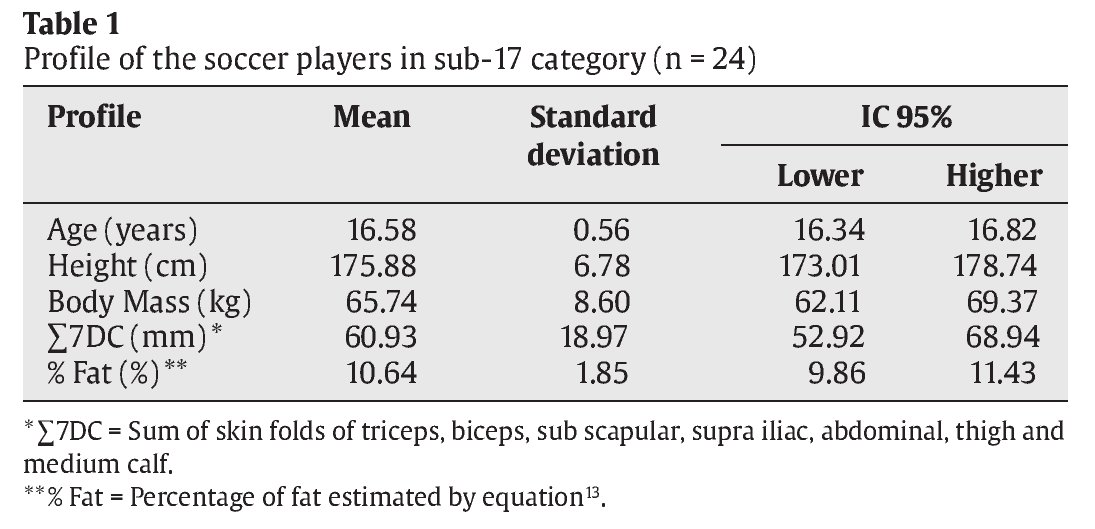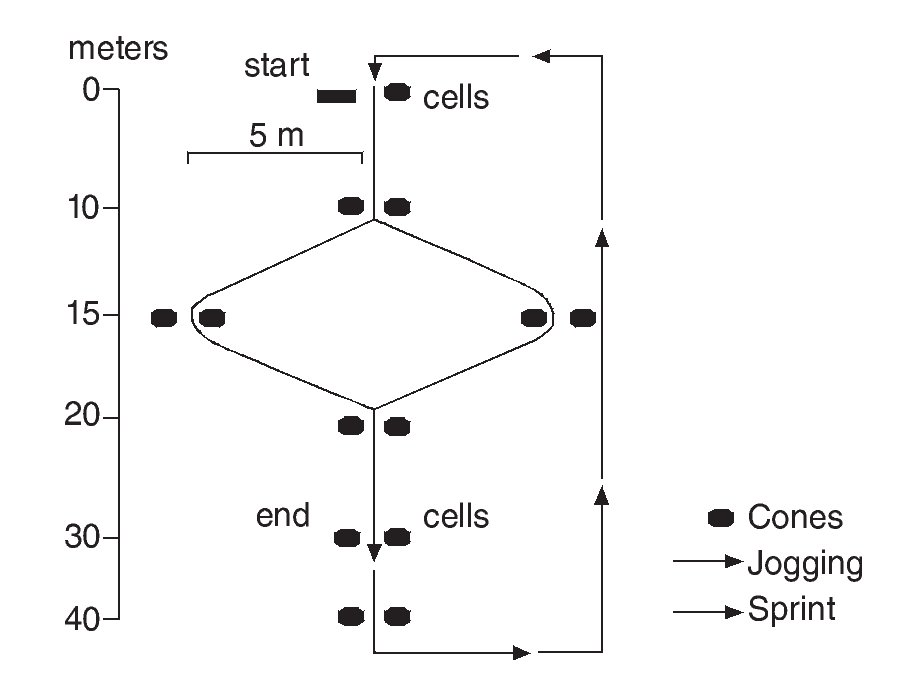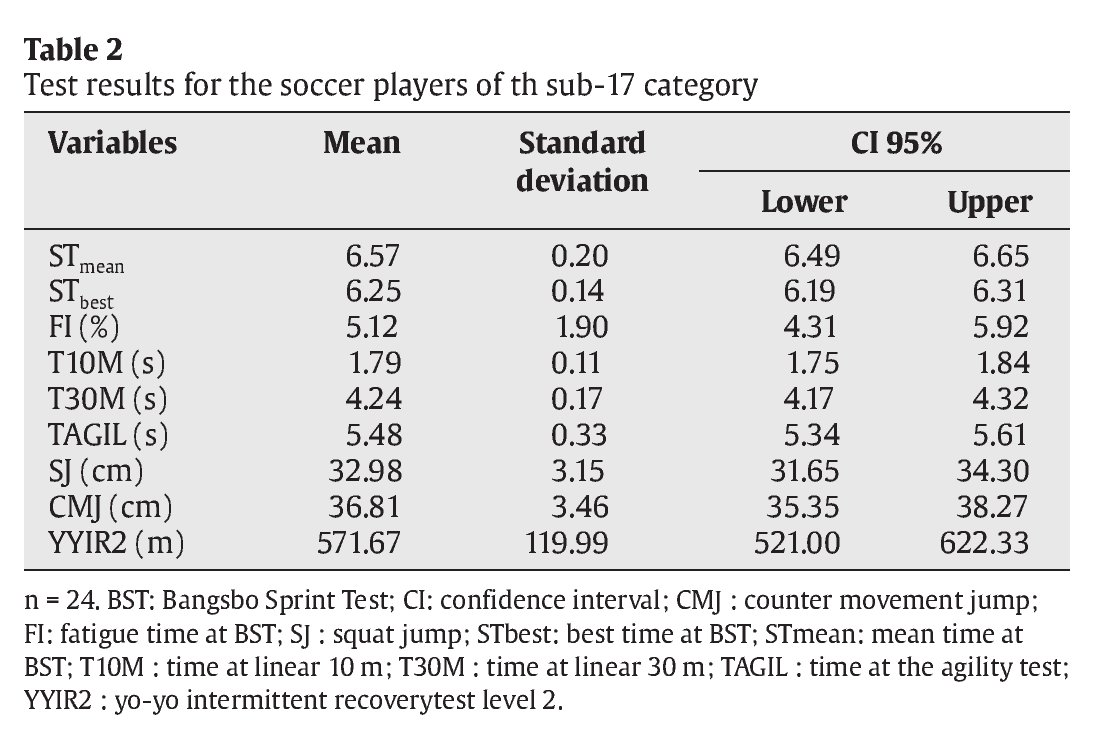Introduction
Predominant actions in soccer are found in the aerobic context. In a recent study, Bradley et al1 showed a rate of 1:3 in distances taken at high intensity (> 14.4 km/h) in relation to low and moderate intensity sprints. However, the most determinant actions in a game are best influenced by the anaerobic system.
Sprints contribute approximately from 1 to 11% of the total distance during a game1-4, but in crucial situations they may influence the result of a game as to ball recovery in defense and in decisive actions of attack. Also, in this context, Bloomfield et al5, showed that over five thousand actions involving spinning take place during a game, of which more than 700 are intentional6, and most movements of deceleration and change of direction occur in a < 90°5,6 angle.
In soccer, actions take place in a stochastic way; variations of intensity and directions are frequent and soccer players are required to perform these actions repeatedly and in different directions. Therefore, the capacity to make repeated sprints, acknowledged by the international literature as repeated sprint ability, has been investigated.
In an attempt to understand the physiological mechanisms involved with the repeated sprint ability, many tests have been proposed and validated upon protocols that vary from the distance of sprints to number of repetitions, duration of interval between the sprints, type of recovery (active and passive) and type of sprint (linear and with change of direction). Nevertheless, many of these protocols do not set a logic validity in a way to allow the replication next to the actions taken during the game as they do not take into account the nature of multidirectional sprints with active recovery between high intensity efforts as found in modalities of intermittent nature such as soccer7.
Thus, the so-called Bangsbo Sprint Test (BST)8, designed for the evaluation of the capacity of soccer players to perform repeated sprints, uses sprints with change of direction and active recovery. According to a study by Abrantes et al9, this test allowed for the distinction between differences of performances of 146 soccer players of six different age ranges and competition levels. Another study detected the BST sensitivity in positive adaptations after the use of different and specific methods for soccer training10, as well as good reproductibility7. And therefore, they fit important validity criteria as cited by Impellizzeri and Marcora11.
Other tests are used for the assessment of important physical capacities in soccer, such as linear sprint, agility and lower limbs power -which are all related to actions of acceleration, counter movements, jumps, kicks, etc.12. Good performance in such actions also relates to the capacity to perform them repeatedly during a game without decrement. Thus, tests of aerobic endurance are also suggested. The aerobic capacity helps in the recovery upon the predominance of anaerobic efforts and in the prevention of fatigue during a game12.
The BST is a test whose protocol comprehends actions from some of the physical capacities above. However, there has been no study so far that could show the contribution of these capacities in BST. With the purpose to have a better understanding of such correlation, the aim of this study was to verify the level of association of the BST variables with the performance in tests of linear sprint, agility, lower limbs power and specific intermittent endurance in young soccer players.
Methods
Sample
The study involved 24 soccer players from the Under-17 category taking part of the State 1st Division Championship. Out of them, five were forwards, four wingers, six midfielders, four centerbacks and five fullbacks. Table 1 presents the profile of the players who took part of the study. The team trained four to six times a week for approximately 120 minutes each session and had been playing under this modality for over five years. They were at the initial stage of preparation and were not taking part of any championship at the moment. The tests were applied in the first week of this stage when the players had just resumed their training after three weeks with no systematic work.
All the athletes were familiar with the assessment procedures used in the study. Notwithstanding that, after being informed orally and in writing about the purpose and the procedures of the study, their parents or guardians signed a term of free and acknowledged consent. The study was approved by the Committee of Ethics in Research from the State University of Londrina under protocol number 062/01.
Collection of data
Previous to the application of the tests, a standard warm-up of approximately 15 minutes, with low intensity runs, dynamic and static stretching and short sprints, followed by five to ten minutes of recovery was made. The test of specific intermittent endurance was taken indoors and the others in a soccer field where the athletes wore specific shoes for the modality.
Bangsbo Sprint Test
The protocol for the BST consisted on seven maximal 34.2 m sprints. Each sprint was made with change of direction (< 90°), as in figure 1, and was evaluated by photocells for measures of time (Hidrofit®, Belo Horizonte-MG, Brazil) positioned at the start line (0 m) and at the end line of the test (34.2 m). Each one was alternated by change of side (right/left), as described by Wragg et al7. The recovery in between sprints was made in an active way and the athlete had 25 seconds to run 40 m and return to the start line. The recovery time was checked through a manual chronometer in order to assure that the subjects would return to their initial position in 23 or 24 seconds. Also, a verbal feedback was given to the athletes at their 20 and 25 seconds recovery. This protocol evidenced good reproductibility [coefficient of variation = 1.8% (interval of reliability 95% = 1.5 - 2.4%)]7. The performance evaluation used the mean time (TMED-BST-BST) and the shortest time (TMIN-BST) between the seven sprints. The TMED-BST-BST and TMIN-BST variables seem to be useful for the assessment of performance in repeated sprints tests and have also been used in other studies for the analysis of test validity of this capacity14,15 and for checking BST reproductibility7. Besides, the index of fatigue (IF-BST), which allows the evaluation of percentage of performance deceleration in between sprints, was calculated by the following equation15: IF-BST (%) = (TMED-BST-BST / TMIN-BST x 100) - 100.
Fig. 1. Schematics of Bansgsbo Sprint Test 8, adapted by Wragg et al7.
Linear Speed
A test of 10 and 30 m, as suggested by Svensson et al12, was used for the assessment of linear speed. Photocells measured the times at the start line (0 m) and at 10 (T10M) and 30 m (T30M), with approximately 0.6 m of height. The athletes performed two maximal sprints with 10 minute rest in between and their best individual result was used for analysis in this study.
Agility
For the capacity of agility, the Square test16 was applied, with 4 x 4 m marked with cones. The time was recorded by photocells positioned at the start line (TAGIL). The athletes were asked to run at maximal speed and make their spins as fast as possible. They started with a diagonal direction sprint from the start line followed by a run toward a cone on the right side. Next, they had to make a counter diagonal movement in the direction of the cone and finally run toward the last cone as positioned at the starting mark. The test was made twice and the best result was used for the analysis in this study.
Yo-Yo Intermittent Recovery Test Level 2
The Yo-Yo Intermittent Recovery Test Level 2 (YYIR2)17 has been frequently used in soccer18-21 and allows the assessment of the specific intermittent endurance next to high intensity actions during a soccer game22. The test comprehended two-way runs of 20 m (2 x 20 m), totaling 40 m, with increased speeds controlled by sound signals. In between each sprint, the athletes had a ten second active recovery of 2 x 5 m walk. The performance analysis was determined by the total distance taken, and the test was considered completed whenever the athlete failed twice in the attempt to reach the final line within the time set by the sound stimulus or whenever the athlete abandoned the test voluntarily. The last distance in which the athlete failed to reach the final mark was considered for the determination of distance17.
Lower Limbs Powe
Two different techniques of technical jumps, as suggested by Bosco23, were used: squat jump (SJ) and counter movement jump (CMJ), with no aid from the arms. A contact mat (Hidrofit®, Belo Horizonte-MG, Brazil) was used for testing these variables. Each jump was repeated three or four times and the analysis took into account the highest value of each one of the techniques.
Statistical Analysis
Data normality was verified by the Shapiro-Wilk test, with parametric procedures of statistics, upon acceptance of normality presumptions. The tests were described in means of central tendency (mean) and measures of dispersion (standard deviation and 95% reliability interval). For the association of the BST variables, the Pearson correlation coefficient (r) and coefficient of determination were used (r2). The SPSS 17.0 software was used for the data analyses and was adopted as significant p < 0.05.
Results
Table 2 presents the results obtained in the tests of repeated sprints with linear speed for 10 and 30 m, agility, SJ and CMJ jumps and specific endurance by YYIR2.
The correlation values between BST variables can be seen in table 3. TMED-BST-BST variable had a statistically significant correlation between TAGIL and YYIR2 (r = 0.57, p < 0.05; r = -0.46, p < 0.01, respectively). As TMIN-BST variable, the correlations were significant (p < 0.01) for TAGIL, SJ, CMJ and YYIR2 (r = 0.49; r = -0.41; r = -0.47; r = -0.41, respectively). The IF-BST variable had a statistically significant correlation (p < 0.01) for T10M and T30M variables (r = -0.49; r = -0.49, respectively).
Discussion
The purpose of this descriptive correlational study was to verify the correlation between a test of specific repeated sprints for soccer (Bangsbo Sprint Test), and the tests of linear speed, agility, lower limbs power and specific intermittent endurance.
A moderate correlation between IF-BST (r = -0.49, p < 0.01) and T10M and T30M variables was found. However, the correlation between these variables could not be justified as the performance related to them is resultant from different energetic systems and this may have been influenced by personal characteristics. The use of fatigue indicators has been refused in tests of repeated sprints15,24 due to a variability in the magnitude of such indicators when compared to different models of fatigue index25.
Thus, Oliver24 proved the utility of fatigue indices to be doubtful and that other measures such as average time, total time, best time and individual times in each sprint are sufficient for the assessment of the capacity to perform repeated sprints.
No correlation between TMED-BST-BST and TMIN-BST and the test of linear speed of 10 and 30 m (T10M and T30M, respectively) was found. In the study by Rabelo et al26, with soccer players from the Under-20 category (n = 73, age: 17.8 ± 0.9 years), there were only weak and moderate correlations between T10M and T30M in relation to TMED-BST-BST and TMIN-BST. Nevertheless, the test protocol for repeated sprints in their study may have favored the correlation findings as it involved unidirectional sprints, which may explain the likely association with linear speed tests.
It can be inferred that the relation between the repeated sprints tests and the tests of linear speed and agility is influenced by the type of run in the test protocol of repeated sprints (unidirectional run or run with change of direction). Moderate correlations as to TMED-BST-BST and TMIN-BST were found for the TAGIL variable. However, the values of 95% interval of reliability showed that there may be moderate to strong correlations in both BST variables. Up to this moment, no further studies have demonstrated the relation of repeated sprints tests to tests of agility. Nevertheless, one can infer that the capacity to perform short changes of direction has an important role in the BST performance as the protocol for this test covers those actions.
In regard to the tests of SJ and CMJ, only the TMIN-BST presented significant moderate correlations in a review study, thus corroborating to the results of Brughelli et al27, which evidenced a weak to moderate relation (r = 0.40, approximately) between tests involving change of direction and lower limbs power. The correlations found in this present study were closely similar to those mentioned in a previous study (SJ: r = -0.41; CMJ: r = -0.47). Therefore, due to the specificities of each test, it can be said that the lower limbs power contributes, even if in a small scale, to the BST performance, and that this contribution is influenced by the great involvement of power in movements of deceleration, followed by change of direction and re-acceleration. These actions are part of those sports with intermittent characteristics as soccer5 and should be taken into consideration upon the use of specific tests as BST7,8. In this sense, some studies have shown that the training of power may improve the performance of acceleration28-30 and agility31 of soccer players.
Nevertheless, no other studies have been found that could evidence how such training can affect the performance in tests of repeated sprints with changes of direction.
The YYIR2 has been used in the assessment of specific endurance capacity for sports of intermittent characteristics in which the aerobic and anaerobic systems contribute for energy production. The main focus of this test is the evaluation of recovery after intense efforts that are essential in some given periods of the game. Besides, it comprehends fast deceleration, change of direction (180°) and re-acceleration, counting with the contribution from the muscle strength. The relation between the TMED-BST and the YYIR2 shows that 21% (r2) of the result of TMEDBST may be explained by the final distance in the YYIR2, and prove the contribution of the aerobic-anaerobic metabolism in the BST.
For the TMIN-BST-BST variable, a moderate correlation (r = -0.41) was found, which also is an evidence of the contribution of the metabolism, even if in a small degree. Other studies, with the use of protocols for tests different from this one, showed a weak relation between the performance in repeated sprint tests and the aerobic endurance of soccer26,32-34, basketball35 and Australian football players36. Only in the study by Buchheit37 was a strong correlation (r = 0.88) found between both capacities in young handball players.
Ferrari Bravo et al38 showed that methods of training that are based on repeated sprints with change of direction can greatly improve the performance in both repeated sprints and the distance in the YYIR1 (yo-yo intermittent recovery test level 1) of young soccer players (age: 17.3±0.6 years; n = 13). This same study showed that this training method was more effective for the improvement of these two capacities in comparison to the training with interval run (n = 13)38. In a recent study with badminton players of both sexes and national competition level, Walklate et al39 identified significant improvements in the test of repeated sprints with change of direction after a training involving actions similar to those of the test. These findings showed that repeated sprints with changes of direction may also be used as an efficient training strategy for the improvement of important capacities required in competition.
Despite the efforts to control the variables that could influence the tests results, some restraints were acknowledged in this study. The training phase of the athletes may have affected some variables negatively. They were just resuming their practice after having spent three weeks with no systematized work and, therefore, their physical capacity could have had some decrement. Another consideration is given to the fact that, even being used to actions as those required by the BST during training and games, the completion agenda did not allow for the test of reproductibility, as suggested by Wragg et al7. Nevertheless, the study by Glaister et al40 showed a high reproductibility in repeated sprints test-retests, requiring no familiarity on the part of the subjects.
Finally, the age range and competitive level have a low external validity, suggesting that the results of this study may apply to a specific population until further studies be published in the scientific literature. However, for a better understanding of the results obtained from the BST, larger samples with different categories and competitive levels should be used. Besides, the variables of this test should be associated with the protocols of similar tests involving unidirectional sprints.
In general terms, the BST variables seem to be related, even in weak and moderate magnitudes, to components of sprints involving short changes of direction (TAGIL), lower limbs power (SJ and CMJ) and the capacity of intermittent specific endurance (YYIR2). As no strong relation to any of the tests aforementioned was found, no matter how the relevance of these capacities for the performance of soccer players and most of all, the fact that they are repeatedly demanded actions during a games course, one must infer that the ability to repeated sprints with change of direction is a particular action that requires a specific test for its assessment. Thus, the BST can be seen as a tool for the evaluation of such a capacity in young soccer players.
Correspondence:
B.N. Pasquarelli.
Av. Rui Barbosa, 2412,
Santana, São José dos Campos-SP, CEP 12212-000. Brasil
E-mail:
brunopasquarelli@hotmail.com
History of the article:
Received January 12, 2010
Accepted April 30, 2010



